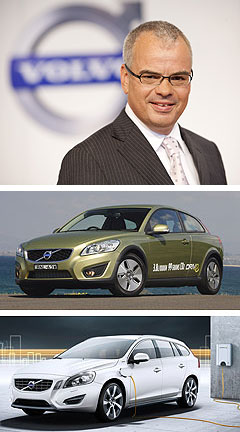Make / Model Search
News - VolvoVolvo says no to A1 rivalEntry model: The C30 hatch will remain the smallest member of Volvo's global line-up... for now. Rebuilding still the priority but Volvo CEO admits a premium light hatch is on radar12 Oct 2011 By BYRON MATHIOUDAKIS in SWEDEN VOLVO’S smallest car for now will continue to be the C30 as the brand concentrates on overhauling an ageing line-up and filling in more pressing – as well as profitable – gaps in the marketplace. Speaking to the Australian media at Volvo Car Corporation head office in Gothenburg, Sweden, this week, CEO Stefan Jacoby admitted that it would be ideal for Volvo to have the luxury of fielding models across the size spectrum but that Volvo had limited resources and more pressing issues. This includes bringing to market the long-overdue ‘C40’ five-door hatch to take on the Volkswagen Golf from next year (2013 in Australia), as well as an SUV and ‘XC Cross Country’ versions to sit below the successful XC60. Speaking of crossover vehicles, Volvo will also field the much-delayed replacement for the old – if still popular – XC90 seven-seater luxury SUV from 2014, while rolling out the electrification and/or forced-induction processes that will work hand-in-hand with Volvo’s future four-cylinder-only drivetrain strategy in both petrol and diesel configurations. “We have obviously limits … and our focus is to do our core models in a competent way, and to do it right rather than to extend our model range further,” Mr Jacoby told GoAuto. “I think that a smaller car concept might follow later, but I do not see as yet this to be a priority. “At Volvo we need to establish our new technologies, and developing and bringing to market attractive new models to the marketplace … and only then, at a later stage, could we talk about extending our model range.”  Left: Volvo Car Corporation CEO Stefan Jacoby. Below: C30 DRIVe and V60 Plug-in Hybrid. Left: Volvo Car Corporation CEO Stefan Jacoby. Below: C30 DRIVe and V60 Plug-in Hybrid.Asked if a B-segment car for Volvo would fit with the brand, Mr Jacoby said that it could definitely be accommodated, and this issue has been the subject of debate. But he quickly followed on that the smart money is on bringing to market models like the next-generation XC90, to help generate more cash for new models in the longer term. “We do need to set priorities,” Mr Jacoby explained. “We have limited capacities and resources. We intend to change from the top down, as this also makes more financial sense (than) entering into a segment where it could not possibly generate as much profit as the more established and premium segments.” Vice-president of global marketing Richard Monturo said a sub-C30 hatchback would probably be inevitable given general consumer trending around the globe. “I can definitely see a (B-segment) Volvo … but just not yet,” he said. “Attending to our core models is our priority. We have to look after our bread and butter cars first.” Mr Monturo added that Volvo’s response to consumer needs for a more fuel-efficient vehicle is being met anyway with ultra-competitive fuel economy and sub-100 grams per kilometre carbon dioxide emissions ratings for models such as the C30 Drive. “The way I see it, there are two things that manufacturers can do right now,” he said. “Most can go down the miniaturisation path, but that is a kneejerk reaction or they can improve the efficiency of their models. And the V60 Plug-in Hybrid is a perfect example of this.” Volvo Car Australia managing director Matt Braid said the time is not yet right for the brand in Australia to venture down a segment. “There is scope for a light car (to rival the Audi A1), but it won’t happen overnight,” he said. “It has been discussed, though.”  Read more |
Click to shareVolvo articlesResearch Volvo Motor industry news |











Facebook Twitter Instagram